Best Gold ETFs in Australia
Last Updated on 20 February 2024 by Ryan Oldnall
Gold has traditionally served as a reliable investment choice, valued for its stability in the investment landscape. Many consider gold to be a secure asset, with its prices often influenced by the dynamics of supply and demand.
In the era of Exchange-Traded Funds (ETFs), there is a proliferation of ETF options covering a wide array of assets, and gold is no exception. In this article, we will examine ETFs specifically focused on physical gold rather than those associated with gold mining or exploration.
Our analysis of ASX Data will delve into the top Gold ETFs in Australia, addressing your most asked questions. For instance, does investing in these ETFs grant you actual ownership of physical gold, or is it akin to having thousands of dollars in your bank account without ever physically holding it.
How To Invest In Gold ETFs In Australia
Investing in Gold ETFs (Exchange Traded Funds) in Australia is a straightforward process. Here are the general steps to help you get started:
Open a Brokerage Account:
Choose a reputable brokerage platform that offers access to the Australian Securities Exchange (ASX). Some popular online brokers in Australia include CommSec, SelfWealth, and CMC.
Verify Your Identity:
To comply with regulations, you’ll likely need to provide some identification documents to open and verify your brokerage account.
Deposit Funds:
Deposit funds into your brokerage account. Most brokers accept electronic funds transfers (EFT) or bank transfers.
Research Gold ETFs:
Identify the Gold ETF you want to invest in. Those we will cover in greater depth later.
Place an Order:
Log in to your brokerage account and place an order for the chosen Gold ETF. You can specify the amount of money you want to invest or the number of units you want to purchase. Most require a minimum of $500 when initially purchasing an ETF
Monitor Your Investment:
Keep track of your investment by regularly checking your brokerage account. You can monitor the performance of the Gold ETF and track changes in its value over time.
Consider Costs:
Be aware of any fees associated with buying, selling, or holding the Gold ETF. Brokerage fees, management fees, and other costs can impact your overall returns.
Tax Implications:
Understand the tax implications of your investment. Capital gains tax may apply when you sell your Gold ETF units at a profit.
Australian Gold ETF ASX
Here is a breakdown of the different ASX listed Gold ETFs we will be analysising along with their funds under management, ETF objective, underlying assest, index, inception date and if the physical gold is held with owner ship of the ETF.
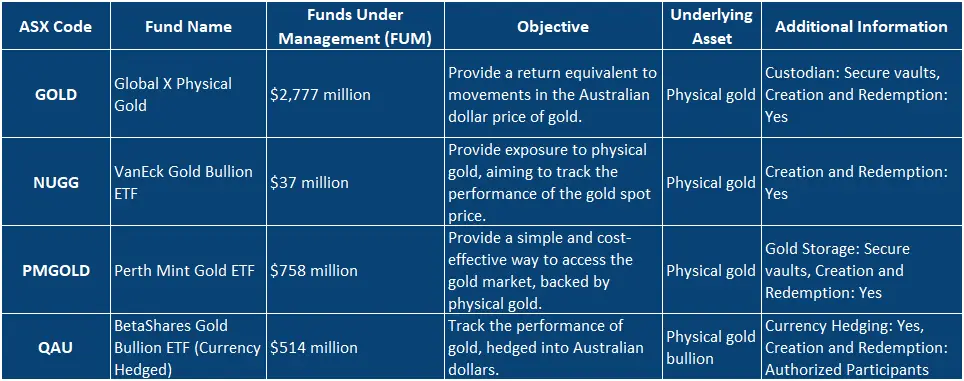

Top Gold ETFs in Australia – Management Expense Ratio (MER)
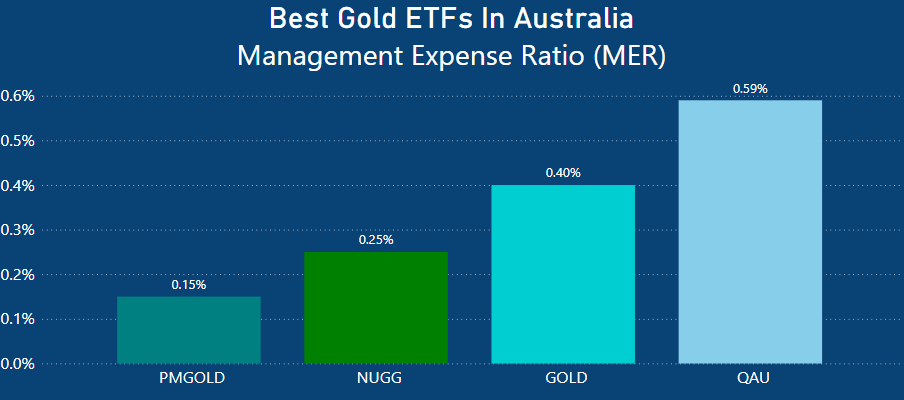 The Management Expense Ratio is a metric that measures the total costs linked to managing and operating an investment fund, expressed as a percentage of the fund’s average net assets. The MER comprises various fees and expenses, including management fees, administrative costs, and other operational expenses incurred by the fund.
The Management Expense Ratio is a metric that measures the total costs linked to managing and operating an investment fund, expressed as a percentage of the fund’s average net assets. The MER comprises various fees and expenses, including management fees, administrative costs, and other operational expenses incurred by the fund.
For investors, the MER is a vital metric providing insight into the ongoing costs of holding a particular fund. A lower MER is generally considered more favorable for investors, indicating that a smaller portion of the fund’s returns is being consumed by fees.
PMGOLD distinguishes itself with the lowest Management Expense Ratio (MER) among the highlighted Gold ETFs, standing at an impressively low 0.15%. Interestingly, PMGOLD takes a unique approach by not physically holding the gold when purchased, setting it apart from its counterparts, all of which securely hold physical gold bullion.
The NUGG ETF, the most recent addition to the list with an inception date of 5/12/2022, carries a slightly higher management fee of 0.25%. In contrast to PMGOLD, NUGG ensures the physical holding of gold bullion, stored within the Perth Mint’s vault.
This ETF is supported by physical Australian origin gold bullion bars, providing investors with a tangible asset traded on the ASX and redeemable at an Australian vault.
The aptly named GOLD ETF by Global X features a management fee of 0.40%. As the largest gold ETF in the group, with assets nearly four times the size of PMGOLD at $2.77 billion, GOLD ETF physically holds gold in a London vault, reinforcing its position as a significant player in the gold ETF landscape.
Betashares Bullion QAU, established in 2011, carries a management fee of 0.59%. Similar to its counterparts, QAU is physically vault-held in a London fault.
Despite a slightly higher management fee, QAU maintains a significant presence as the third-largest ETF in the group, boasting assets totaling $514 million.
These Gold ETFs offer investors a spectrum of options, each with its unique approach to gold investment, whether through low management fees, physical gold holding strategies, or substantial fund sizes.
Top Gold ETFs in Australia – 1 Year Return
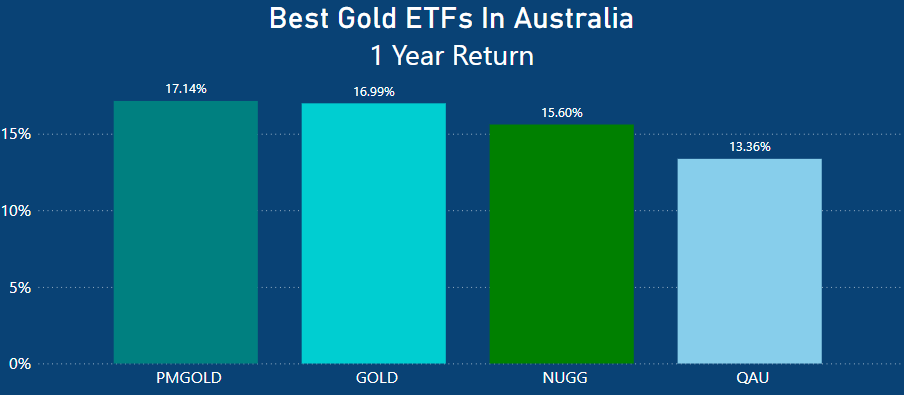 When examining the one-year performance of various ETFs, PMGOLD stands out with the highest return at 17.14%, slightly surpassing GOLD, which achieved a 16.99% return over the same period. It’s essential to recognize that not all Gold ETFs share the same performance characteristics.
When examining the one-year performance of various ETFs, PMGOLD stands out with the highest return at 17.14%, slightly surpassing GOLD, which achieved a 16.99% return over the same period. It’s essential to recognize that not all Gold ETFs share the same performance characteristics.
The impact of shifting exchange rates plays a significant role in returns. Unhedged securities like GOLD & PMGOLD can benefit from a depreciating Australian Dollar against the U.S. Dollar, potentially passing on currency gains to investors, provided all other factors remain constant.
NUGG, the most recent addition to the ETF lineup, has completed its first year on the market, delivering a solid return of 15.60%.
Conversely, the current underperformer over the one-year period is QAU, with a return of 13.36%. QAU is a currency-hedged ETF, strategically managing fluctuations in the Australian and U.S. Dollar exchange rates through financial instruments to minimize investors’ exposure to these currency changes.
It’s important to note that the returns primarily mirror those of the gold price and exclude currency risk. For instance, if the Australian Dollar strengthens against the U.S. Dollar, it could potentially have a negative impact on returns.
Top Gold ETFs in Australia – 3 Year Return
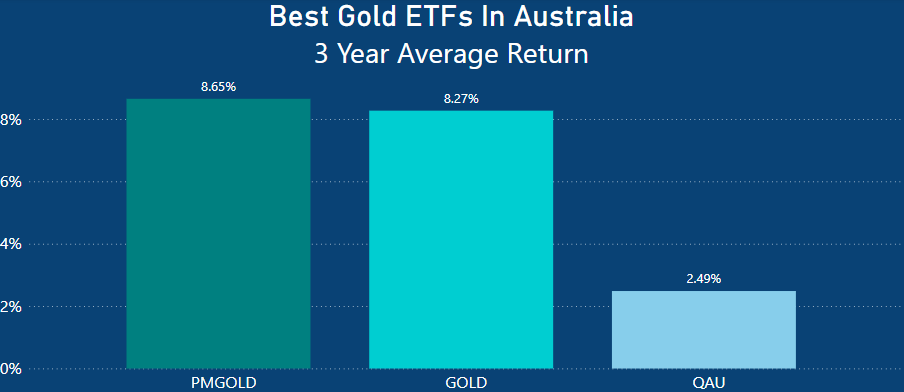 When analyzing the average returns over three years and beyond, NUGG is excluded from consideration due to its relatively short listing period of just over a year.
When analyzing the average returns over three years and beyond, NUGG is excluded from consideration due to its relatively short listing period of just over a year.
Once again, PMGOLD and GOLD exhibit very similar performances, yielding average returns of 8.65% and 8.27%, respectively, over the three-year period. These ETFs have benefited from being unhedged against the US dollar.
In contrast, the performance gap has significantly widened for QAU, with both PMGOLD and GOLD delivering over three times the returns. QAU, over the three-year period, returned an average of 2.49%.
Top Gold ETFs in Australia – 5 Year Return
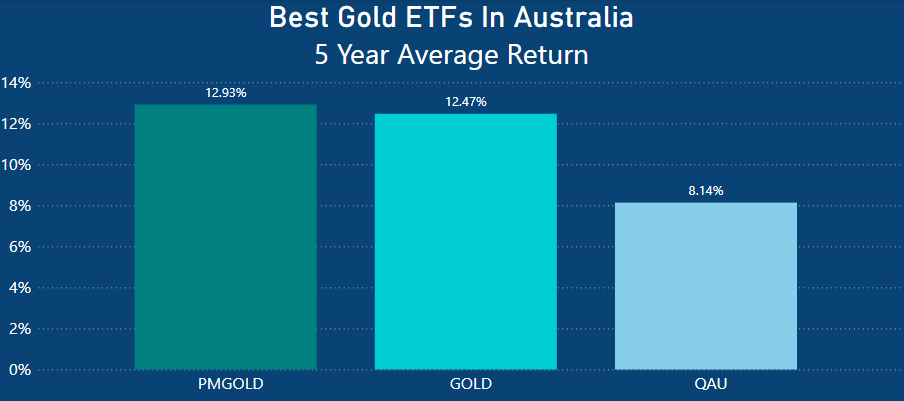 In the analysis of the 5-year average returns of the ETFs, QAU has narrowed the gap but still trails behind both PMGOLD and GOLD.
In the analysis of the 5-year average returns of the ETFs, QAU has narrowed the gap but still trails behind both PMGOLD and GOLD.
PMGOLD delivered an impressive 12.93% on average over 5 years, while GOLD achieved a solid 12.47%. In contrast, QAU, constrained by its status as a hedged ETF, returned 8.14%, representing a 4.33% average lag compared to GOLD.
Once again, the observed disparities in performance underscore the impact of currency hedging, emphasizing that unhedged ETFs such as PMGOLD and GOLD have exhibited more robust returns over the specified time frame.
Investors should carefully consider these factors when evaluating the long-term performance of Gold ETFs within their portfolio, recognizing the influence of currency hedging on overall returns.
Summary – Is Gold Worth It?
Overall, holding Gold in a portfolio is not too common. While it is considered relatively stable, especially when factoring in historical performances, the value of Gold is primarily driven by supply and demand and itself does not generate income.
This characteristic distinguishes Gold ETFs from the more traditional options like VAS, IOZ, and A200. The key difference lies in the fact that the core holdings of these ETFs generate revenue and, in most cases, profit. This dynamic drives the growth of individual holdings and the ETF as a whole.
The decision to hold a Gold ETF may depend on personal views on gold, individual circumstances, and financial goals. Understanding these nuances is important in making informed decisions about incorporating Gold ETFs into a diversified investment portfolio.
This article does not serve as an endorsement or recommendation for products mentioned in the article. The information presented here is based on referenced sources and is accurate as of the date of December 31, 2023 using ASX November Data. Please note that these articles are written sometime before their publication date.
The information provided in this content is for informational purposes only and should not be considered as financial, investment, or professional advice. We recommend consulting with a qualified expert or conducting your own research before making any financial decisions.
The accuracy, completeness, or reliability of the information cannot be guaranteed, and the provider shall not be held responsible for any actions taken based on the information contained in this content.







